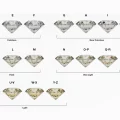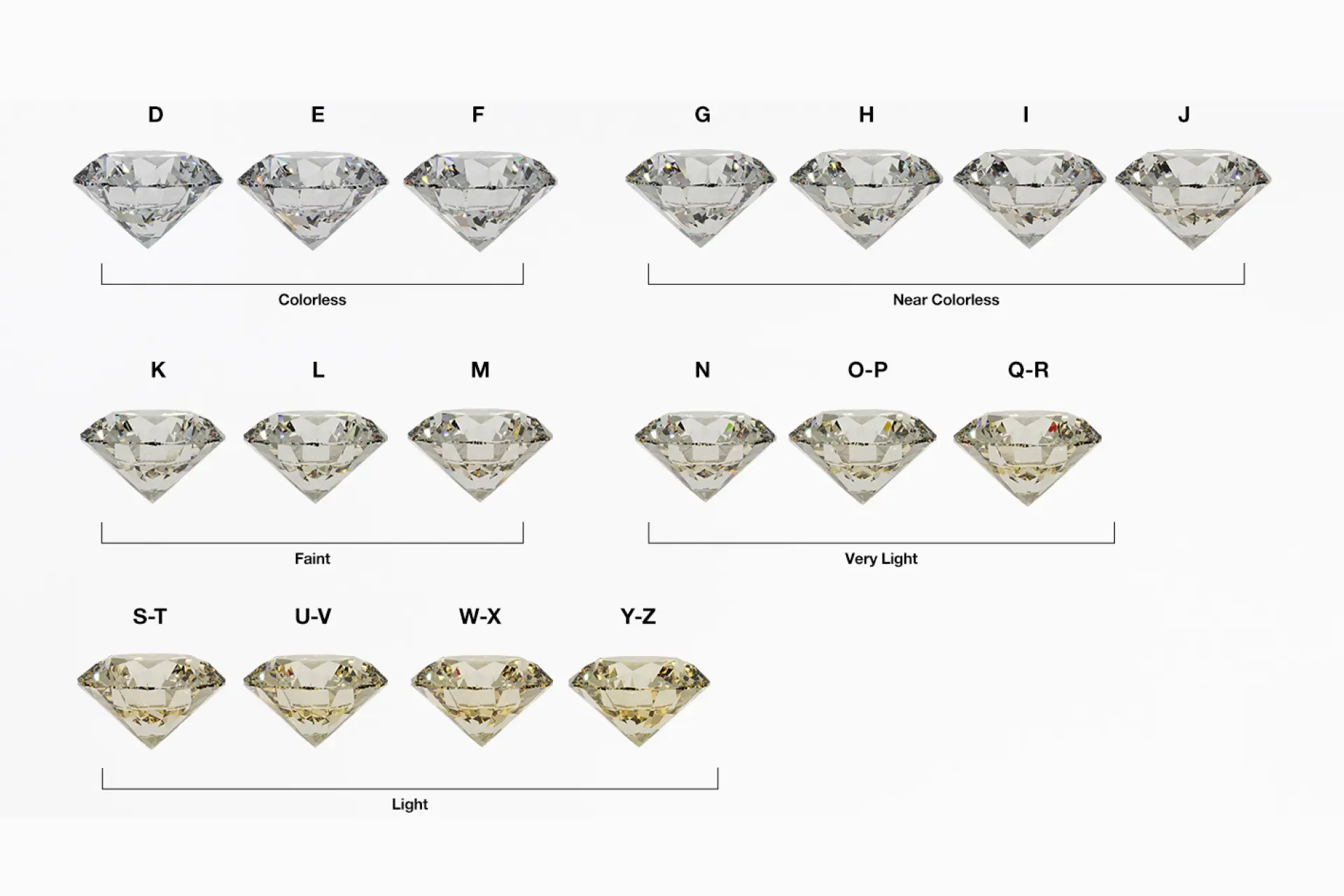Understanding the Diamond Color Grading is essential for assessing its quality and value. Contrary to what some may believe, a diamond’s color does not refer to the presence of a specific color (with the exception of fancy colored diamonds), but rather to the degree of colorlessness in a white or transparent diamond. The closer a diamond is to completely colorless, the more valuable and rare it is.
Understanding the Diamond Color Grading: A Complete Buyer’s Guide
Gemologists (usually at independent laboratories such as the GIA) grade a diamond’s color by comparing it to a group of known color-matched gemstones under controlled lighting conditions and in a neutral environment (often a white background). Diamonds are examined “loose” (not mounted in a ring or piece of jewelry) to ensure that the color is not affected by the color of the surrounding metal.
Learn about how diamond clarity influences its appearance and value
What Is Diamond Color Grading and Why It Matters
- Value: The closer a diamond is to a “D” (colorless) grade, the more rare, valuable, and expensive it is.
- Appearance: Color directly affects the overall appearance of a diamond. Colorless diamonds reflect light more brilliantly, especially when paired with the right Diamond Cut
- Personal Choice: While colorless diamonds are considered the most valuable, some people prefer lower-grade diamonds (such as G-J) because they offer a near-colorless appearance at a more competitive price, especially if they are mounted in yellow gold, which can hide any slight tint.
- Investment: For investors, a thorough understanding of color grade is vital, as even a small change in grade can affect value by thousands of dollars.
The GIA Diamond Color Scale Explained
The Gemological Institute of America’s (GIA) Diamond Color Scale is the global standard for grading diamond color and is a key part of the popular 4Cs (Cut, Color, Clarity, and Carat) system. This scale aims to assess the degree of “colorlessness” in a transparent white diamond. The most chemically and structurally pure diamonds are completely colorless, like a pure drop of water, and therefore more valuable.
The Impact of Color on Diamond Brilliance and Value
For white diamonds, which are graded on a scale from D (completely colorless) to Z (light yellow or brown), color affects brilliance in the following ways:
- Colorless Diamonds (D-F): These diamonds are the rarest and most valuable. Their lack of color allows light to pass through them more freely and be reflected and scattered (known as “brilliance,” “fire,” and “scintillation”) with maximum efficiency. This results in exceptional brilliance and sparkle. The closer a diamond is to D, the more clearly and purely it reflects light, increasing its apparent brilliance.
- Nearly Colorless Diamonds (G-J): These diamonds may exhibit a slight hint of yellow or brown, which may not be visible to the naked eye in most cases, especially if set in yellow gold. However, this slight hint can affect how light is reflected, which may slightly reduce brilliance compared to a completely colorless diamond.
- Light-colored diamonds (K-Z): The more yellow or brown a diamond has, the less it reflects pure white light. This color “absorbs” some of the light entering the diamond, significantly reducing its brilliance and sparkle and making it appear more “dull” or “matte.”
Common Misconceptions About Diamond Color
- All diamonds must be colorless or “white”: While colorless diamonds (graded D to Z on the GIA scale) are the most common and sought-after for engagement rings, they are not the only type of diamond. Higher color grades (such as D, E, F) always look noticeably better. In fact, the difference between adjacent grades on the color scale is often significant (especially in the colorless or near-colorless range).
- A diamond with a lower color grade (such as K, L, M) is of poor quality. This is not necessarily true. Diamonds in the lower range of the color scale (with a noticeable yellow or brown tint) can still be very beautiful and have their own sparkle.
- Color is not important in smaller diamonds. Although color may be less pronounced in smaller diamonds, it is still a factor to consider for an overall harmonious appearance, especially if the diamond is part of a larger design or alongside other diamonds.
- Diamond color changes over time: The color of a diamond is stable and does not change over time. What can happen is that dirt and oils build up on the surface of the diamond, making it appear dull or less brilliant, and its color may appear more pronounced. Regular cleaning restores a diamond to its original brilliance.
How Color Grades Are Evaluated by Experts
Diamond color grades are evaluated by experts using a standardized grading system, the most common of which is the 4Cs system developed by the Gemological Institute of America (GIA). This system focuses on four main factors: color, clarity, cut, and carat weight. When evaluating color, experts follow the following steps and criteria:
Laboratory Grading vs. In-Store Observation
- Laboratory grading is a scientific assessment of a diamond’s characteristics (such as the 4Cs) and does not provide a monetary value. It is essential for buyers to ensure transparency and accuracy in diamond quality.
- In-store inspection is an estimate of the monetary value of a diamond or jewelry as a whole and is primarily used for insurance or sales purposes. However, caution should be exercised due to the potential for inflated valuations and conflicts of interest.
Equipment and Techniques Used in Grading
Diamond grading is based on the “4 Cs” criteria: carat, color, clarity, and cut. A variety of specialized equipment and techniques are used to accurately inspect and evaluate diamonds, including:
- Tweezers.
- Loupe.
- Microscope.
- Standard White Light Source.
- UV Lamps.
- High-Precision Balance Scales.
- Color Master Stones Set.
- Lint-Free Cloths.
- Cleaning Liquid.
- Diamond Sorting Pad and Diamond Sorting Sieve.
Why GIA and IGI Certifications Matter
Having a GIA or IGI certification for a gemstone gives buyers confidence in the quality and value of what they are purchasing and ensures transparency in the gemstone market. Both offer reliable appraisal services, and the choice between them may depend on the type of stone (natural or lab-grown), budget, and local market preferences.
Choosing the Right Diamond Color for Your Budget and Style
Choosing the right diamond color for your budget and style is a personal and important decision. A diamond’s color is greatly influenced by its price and overall appearance. To understand how to make this decision, let’s delve into the key factors that influence diamond color and how to balance them:
Color Recommendations by Ring Metal (Platinum, Gold, Rose Gold)
- Platinum has a bright, neutral silver color, making it ideal for highlighting the colors of gemstones. It’s a luxurious metal and reflects light beautifully.
- Yellow gold is a warm, classic metal, adding a touch of sophistication and traditional elegance.
- Rose gold, or red gold, is a modern, romantic metal with a soft pink hue that comes from blending gold with copper.
The Sweet Spot Between Value and Appearance (F–H Range)
When it comes to diamonds, the F-H range on the color grade scale represents a sweet spot between high quality and good value. Here’s why:
- F (Flawless) Color: This is considered the highest grade, as a diamond appears completely colorless to the naked eye. It’s an excellent choice for those looking for the best and willing to pay a slightly higher price for this optical clarity.
- G (Nearly Colorless) Color: This color is very popular and offers great value. Although it falls into the “nearly colorless” category, it is very difficult to discern any color to the naked eye, especially when mounted in a ring.
- H (Nearly Colorless) Color: This color offers an excellent balance between quality and price. Some may notice a very slight tinge of color in certain lighting conditions, but it is often unnoticeable when mounted, especially in white metals like white gold or platinum.
Fancy Color Diamonds vs. Traditional White Diamonds
The choice between fancy colored diamonds and traditional white diamonds ultimately depends on personal preference, budget, and purpose. If you’re looking for a classic, timeless look with brilliance and sparkle, white diamonds are the traditional choice.
Comparing Diamond Colors Side-by-Side
Diamond colors are compared primarily based on the color grading scale developed by the Gemological Institute of America (GIA), which is considered the industry standard. This scale measures the degree of “colorlessness” in a white diamond, with the most valuable diamonds being those that lack any visible color.
Real-Life Examples from D to Z Color Grades
The scale begins with the letter “D,” which represents completely colorless diamonds, and ends with the letter “Z,” which indicates diamonds that have a noticeable degree of yellow or brown color.
How Lighting Affects Perceived Color
Lighting significantly affects the perception of a diamond’s color, as it can alter the way the stone’s true color appears. This is why diamond experts evaluate color under specific, controlled lighting conditions.
Before and After: What You See vs. What You Pay For
- High Quality = High Price: A diamond that scores highly in all 4Cs (large carat, near D color, high clarity, and excellent cut) will command a very high price.
- The 4Cs Trade-off: In most cases, the average buyer cannot afford a diamond that is perfect in every aspect. This is where trade-offs come in. You can choose to sacrifice a little clarity or color for a larger carat or an excellent cut, which may be more important to the naked eye.
- Cut Matters: Diamond experts often consider cut to be the most important factor because it directly affects a diamond’s brilliance and sparkle. A diamond with an excellent cut can make a diamond appear larger and whiter than it actually is.
Frequently Asked Questions About Diamond Color
Is D Color Really Worth the Premium?
The D color in a diamond represents the highest grade on the color scale for diamonds, meaning they are completely colorless. This makes them extremely rare and highly sought after, and therefore commands a high price.
Can You Tell the Difference Between F and H Color?
Distinguishing between F and H color diamonds is often very difficult with the naked eye, especially for the average non-expert.
Which Diamond Color Grade Is Most Popular?
When we talk about the “most common diamond color grade,” we usually refer to white or nearly colorless diamonds. According to the Gemological Institute of America (GIA), diamond colors are graded from D (completely colorless) to Z (light yellow or brown).






